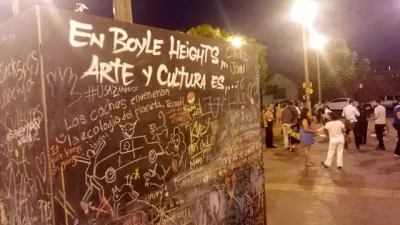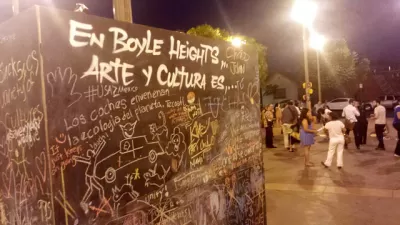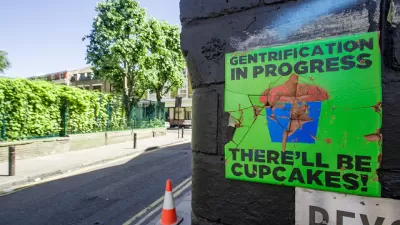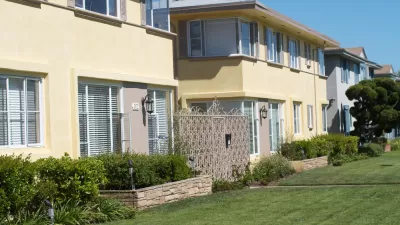The historically Latino working class neighborhood is a frequent touchstone in debates over gentrification in Los Angeles. That history goes back decades and colors residents' perceptions.

Alfredo Huante unpacks Boyle Heights' long and fraught relationship with L.A. city planning, a story that goes back to the 1960s. The memory of invasive urban renewal, he writes, lingers on despite the fact that Boyle Heights escaped the fate of neighboring "blighted" areas with largely Latino populations.
Huante discusses the rise of community planning in L.A. following the Watts Riots, an early effort to address racial disparities in land use decision making. "Although citizen participation in neighborhood planning was readily encouraged in predominantly white, non-blighted neighborhoods, community plans functioned as the first efforts to solicit and collect barrio residents' input in city planning processes."
Despite those moves, a shift of focus to downtown development under Mayor Tom Bradley again sidelined community planning in Boyle Heights, setting the stage for today's acrimonious debates over development and neighborhood heritage.
Through the late 20th century and into the 21st, Haunte writes, "overarching policies of exclusionary land uses prevailed even if political inclusion improved. With downtown redevelopment jumping the L.A. River into Boyle Heights, ongoing discussions and framing over anti-displacement movements are better understood within this history of dispossession."
FULL STORY: Is Boyle Heights “Worth Saving”?

Maui's Vacation Rental Debate Turns Ugly
Verbal attacks, misinformation campaigns and fistfights plague a high-stakes debate to convert thousands of vacation rentals into long-term housing.

Planetizen Federal Action Tracker
A weekly monitor of how Trump’s orders and actions are impacting planners and planning in America.

In Urban Planning, AI Prompting Could be the New Design Thinking
Creativity has long been key to great urban design. What if we see AI as our new creative partner?

How Trump's HUD Budget Proposal Would Harm Homelessness Response
Experts say the change to the HUD budget would make it more difficult to identify people who are homeless and connect them with services, and to prevent homelessness.

The Vast Potential of the Right-of-Way
One writer argues that the space between two building faces is the most important element of the built environment.

Florida Seniors Face Rising Homelessness Risk
High housing costs are pushing more seniors, many of them on a fixed income, into homelessness.
Urban Design for Planners 1: Software Tools
This six-course series explores essential urban design concepts using open source software and equips planners with the tools they need to participate fully in the urban design process.
Planning for Universal Design
Learn the tools for implementing Universal Design in planning regulations.
Gallatin County Department of Planning & Community Development
Heyer Gruel & Associates PA
JM Goldson LLC
City of Camden Redevelopment Agency
City of Astoria
Transportation Research & Education Center (TREC) at Portland State University
Jefferson Parish Government
Camden Redevelopment Agency
City of Claremont





























